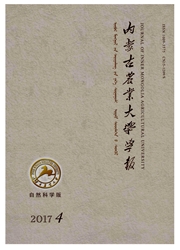

 中文摘要:
中文摘要:
本文选择内蒙古农业大学东校区3种主要的校园绿化树种垂柳(Salix babylonica Linn.)、新疆杨(Populus bolleana Lauche.)、油松(Pinus tabulaeformis Carr.),在晴天树木阴影中心原位测定地面温度、大气温度和大气相对湿度,用来研究不同树种的降温增湿效应。结果表明:(1)行道树下空气温度、地表温度的日变化趋势与对照点相似,呈倒“U”字型;但大气相对湿度的日变化趋势正好相反,呈”U”字型;(2)与对照(附近水泥路面)相比,3种主要行道树都具有明显的降温和增湿效应,尤其是1天的中午时段。尤其是1天中的中午的降温效应更为明显。与对照水泥地相比,3种行道树降低大气温度的平均降温率为4.3%-5.1%,降低地表温度的平均降温率为34.9%-42.9%,平均增湿率为29.5%~34.5%;(3)从降温增湿的综合效应来看,垂柳和油松又大于新疆杨,而油松在降低地表温度和增加空气湿度的效应又要大于新疆杨。这除了与不同树种树冠的几何形状、叶面积指数以及树木长势等的不同有关,可能还与不同树种的枝下高有关。
 英文摘要:
英文摘要:
Effects of reducing temperature and increasing humidity of greenery trees were studied in the eastern campus of Inner Mongolia agricultural University. Three dominating greenery trees Salix babylonica Linn. , Populus bolleana Lauche. and Pinus tabulaeformis Carr. were selected. The results showed that : The trend of diurnal variation of air temperature and topsoil temperature showed adverse curve shape, just for the three tree species and in the cement land, but the change trend of air relative humidity showed adversely. Compared with the cement land, three greenery trees showed obvious ecological effects, especially at the noon. The average reducing rate of air temperature varied 4.3% -5.1% , the amplitude of topsoil temperature and the air humidity variation were 34.9% - 42.9% and 29.5% -34.5% respectively. Among the three tree species,Salix babylonica Linn. had the biggest effects of reducing temperature and increasing humidity, while the effects of Pinus tabulaeformis Carr. was greater than that of Populus bolleana Lauche. This phenomena may be related with the geometrical shape of tree crown, index of leaf area and the growth state and the branch height.
 同期刊论文项目
同期刊论文项目
 同项目期刊论文
同项目期刊论文
 Influences of grassland degradation on forage availability by sheep in the Inner Mongolian steppes o
Influences of grassland degradation on forage availability by sheep in the Inner Mongolian steppes o Contribution of Urine and Dung Patches from Grazing Sheep to Methane and Carbon Dioxide Fluxes in an
Contribution of Urine and Dung Patches from Grazing Sheep to Methane and Carbon Dioxide Fluxes in an 期刊信息
期刊信息
